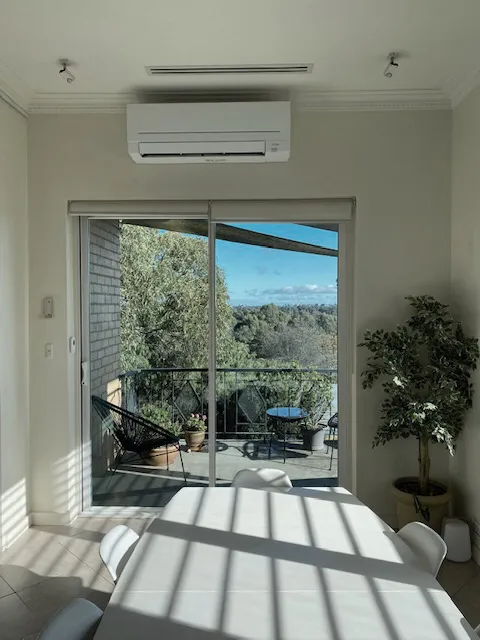Split System Air Conditioner: What is it, Types, Working principle and Pros and Cons

A split system air conditioner is a type of air conditioning system that has an outdoor condenser unit and an indoor evaporator unit connected by refrigerant pipes. The term "split" refers to the two separate units.Split systems are capable of both heating and cooling (split system heating and cooling). They pump refrigerant between the outdoor and indoor units to transfer heat in or out of a home, allowing you to control the temperature.
Split systems are commonly installed in Australian homes and small commercial spaces like offices and shops. According to the Australian Bureau of Statistics, over 40% of Australian homes have reverse cycle split system air conditioners as of 2021.The main working principle of a split system air conditioner is the refrigeration cycle. The cycle uses a refrigerant that absorbs heat and changes between gas and liquid states. The outdoor unit compresses the refrigerant gas, heating it up. The hot gas then passes into the indoor unit and condenses, releasing its heat. This cools and dehumidifies the air. The cycle then reverses to provide heating.
Key advantages of split system air conditioners are their affordability, efficiency and flexibility compared to other types of air conditioning. As they have separate components, the outdoor unit can be installed out of sight and the indoor unit placed for optimum room cooling. They are also quieter than other types of air conditioning.
Potential disadvantages include heat transfer efficiency loss from the long piping, possibility of refrigerant leaks, and their unsuitability for very large spaces. Professional installation is also recommended.
Split system air conditioner costs vary greatly depending on the unit size, features and brand. As a guide, a popular 2.5kW reverse cycle split system unit from a leading brand costs approximately A$1,100 to purchase plus A$880 for installation. Owners should budget for annual servicing and cleaning which may cost around A$220 per service.
What is a split system air conditioner?
A split system air conditioner is a type of air conditioning system consisting of an outdoor unit and an indoor unit connected by refrigerant piping and electrical cables. The term "split" refers to the two separate units. Split systems use the refrigeration cycle to cool and heat the air.
The first split system air conditioner was invented by Stuart Cramer in 1902. His system used fans to blow air over a cold water coil, which was an early form of what would later become modern refrigerant-based air conditioning.
Key components of a split system air conditioner include a compressor and condenser in the outdoor unit, and an evaporator and blower fan in the indoor unit. The two units are linked by copper pipes that allow refrigerant to flow between them.

What Is A Split System?
The term "unit" refers to each individual component that makes up the split system. This includes both the outdoor unit and the indoor unit.
The outdoor unit houses the compressor, condenser coil and fan. It is installed outside the home, usually on the ground or mounted on an exterior wall. The indoor unit contains the evaporator coil and blower fan, and is mounted high up on an interior wall or ceiling.
Different types of indoor units are available depending on the application, such as wall-mounted, ceiling cassette, and ducted units. The installer will determine the optimal indoor unit type based on room size, aesthetics and installation considerations.
Who invented the split system air conditioner?
In the history of air conditioning, the basic concept of the split system can be traced back to the 1902 invention of Stuart Cramer. However, the modern refrigerant-based split system air conditioner was invented later in the 20th century.
Specifically, the split system design allowing separate indoor and outdoor units was patented in 1935 by two Brazilian engineering students, Edson Giunta and Eduardo Kneese de Melo. Their system design enabled air conditioning units to be less intrusive indoors by locating the noisy mechanical components in a separate outdoor unit.
This pioneering split system design by Giunta and Kneese de Melo paved the way for the split system air conditioners widely used for residential heating and cooling today.
How does a split system air conditioner work?
Split system air conditioners work by transferring heat between the inside and outside air. This is accomplished through the refrigeration cycle using special refrigerants and a compressor to control air temperature.
To provide cooling, the split system air conditioner goes through a 4-step process:
- Refrigerant in the indoor unit absorbs heat from the air in the room, causing the refrigerant to evaporate into a gas. This evaporation has a cooling effect.
- The gaseous refrigerant is then compressed by the electric compressor located in the outdoor unit. When compressed rapidly, the refrigerant heats up significantly.
- The hot gas passes through the outdoor coil (condenser), where a fan blows outdoor air though the coil. This allows the hot refrigerant gas to dissipate its heat into the outside air, causing the gas to condense back into a high pressure liquid.
- This liquid refrigerant then passes through an expansion valve in the indoor unit, causing it to turn into a cold, low pressure mixture of liquid and gas. It once again absorbs heat from the indoor air via the evaporator coil, providing cool air circulation into the room via the indoor blower fan. Any accumulated moisture also condenses and drains out.
The most common refrigerant used in split system air conditioners is R410A and R32.
To provide heating, the process is reversed:
- The liquid refrigerant in the outdoor unit absorbs heat from the external air, causing it to evaporate.
- The refrigerant gas is compressed, increasing its temperature.
- The hot gas dissipates its heat indoors via the indoor coil, heating the air.
- It condenses back into a liquid, flowing outside to repeat the cycle.
The cooling and heating capacity depends on the power and size of the indoor and outdoor units.
- Small split systems under 2kw-5kwkW capacity
- Large split systems 5kw to 10kW+ capacity
- Multi-split systems with multiple indoor units connected to one outdoor unit
The power is denoted in the model description, for example a "Mitsubishi 5kW split system air conditioner model is MSZ-AP50VGD-2".


What are the split system air conditioner components?
The components of a split system air conditioner refers to the individual working parts located in either the indoor or outdoor units. They each serve specific functions that enable the heating and cooling process to take place. The main indoor components are:
- Evaporator Coil: A long copper tube filled with refrigerant to absorb heat from the indoor air. This causes the refrigerant to evaporate and cool the air.
- Blower Fan: Circulates the indoor air over the cold evaporator coil then drives the colder air into the rooms through vents and ducts. Essential for efficient circulation.
- Filter: Traps dust, dirt and debris to keep the coil surfaces clean for optimal performance. Needs regular cleaning or replacing.
The main indoor components are:
- Compressor: Raises the temperature and pressure of the refrigerant gas for circulation between indoor and outdoor units. The heart of the split system operation.
- Condenser Coil: Refrigerant from compressor dissipates heat here, condensing the gas into liquid form to repeat the cooling cycle.
- Outdoor Fan: Draws outside air over the hot condenser coil to cool the refrigerant, while blowing out hot exhaust air.
- Expansion Valve: Drops the liquid refrigerant to a lower pressure to resume absorption of indoor heat when it passes back into the evaporator.
Proper functioning of all these components is important for effective and reliable split system heating and cooling.
What are the split system air conditioner types?
There are 3 main types of split system air conditioners: standard split systems, mini split systems and multi-split systems.
A standard split system has one indoor unit connected to one outdoor unit, and is the most common type used in homes.
A mini split system has a smaller, more compact indoor unit for smaller spaces. The outdoor unit is similar in size to standard systems.
A multi-split system has a single outdoor unit linked to multiple indoor units, allowing different rooms to be air conditioned using just the one external compressor. Useful for zones.
Commercially, split systems are often described by the kilowatt (kW) power or capacity of the indoor unit. The kW indicates the potential rate of cooling or heating energy transfer.
Tips for selecting the right air conditioning system:
- 2.5kW small split system air conditioner for bedrooms
- 5kW split system air conditioner for small living rooms
- 8kW large split system for larger living rooms
It's important to choose the correctly sized system for your space. An underpowered system will have to work harder, while an oversized unit is less efficient and has higher operating costs. Getting professional advice is recommended. An inaccurate system sizing can lead to issues with temperature, humidity, mould formation from condensation and higher energy bills.

Get in touch






.png)






.png)